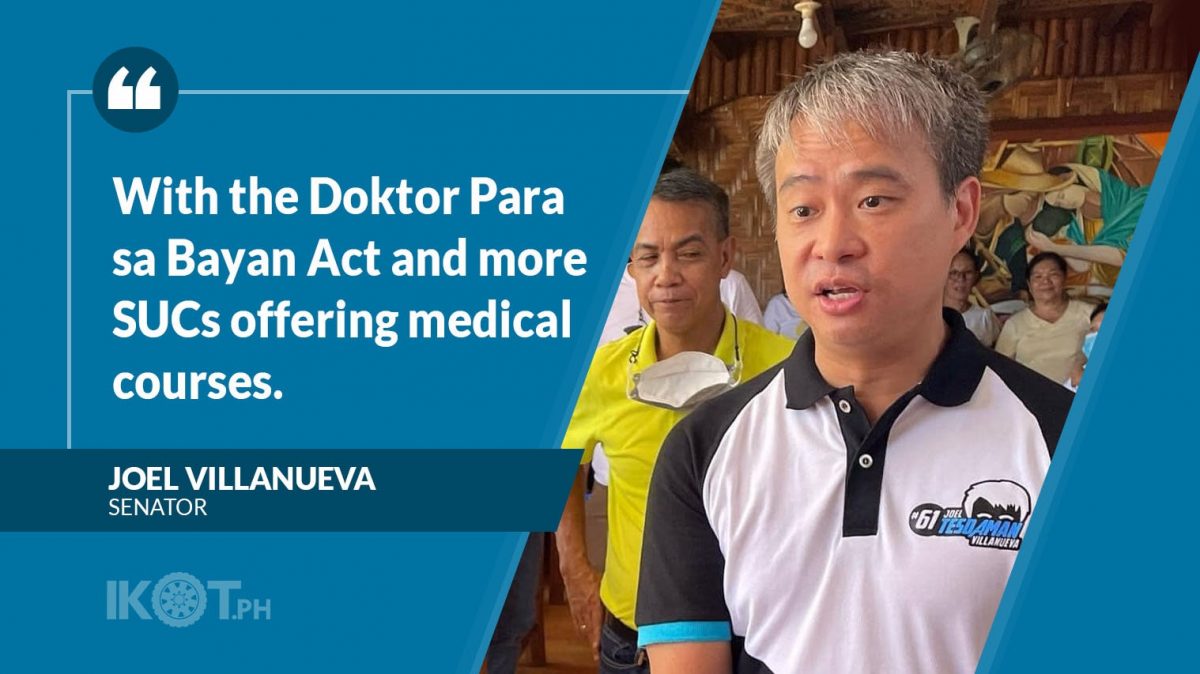Senator Joel Villanueva expressed hope that more future passers of medical board tests will come from the ranks of Doktor Para sa Bayan Act scholars, as he congratulated the country’s 1,427 new doctors.
Despite the addition of the March 2022 licensure examination passers to the ranks of doctors, Villanueva said their total number is still far from the ideal doctor-to-population ratio.
“At the minimum 1 per 1,000, the country has a shortage of 80,000 doctors,” the veteran legislator said.
This shortfall is, however, based on the 2022 population of 110 million, the seasoned lawmaker explained.
“By 2030, our population will increase to 125 million, and 15 million more Filipinos would ideally need 45,000 doctors,” the senator noted.
To address this challenge, he said medical scholarships under the Doktor Para sa Bayan Act have gotten a big boost in this year’s national budget.
“Ang kabuuang pondo po para sa mga iskolar ng bayan na nag-aaral ng medisina ay lampas isang bilyong piso.”
“Ang kabuuang pondo po para sa mga iskolar ng bayan na nag-aaral ng medisina ay lampas isang bilyong piso,” Villanueva said.
He is the principal sponsor and principal author of said law, which President Rodrigo Duterte signed on December 23, 2020, as Republic Act 11509.
Villanueva also sponsored the funding for its implementation in the 2022 General Appropriations Act.
He explained that money for this year’s Doktor Para sa Bayan scholarships will come from different sources.
These are the P500 million under the Medical Scholarship and Return Service program, and P167 million under the existing medical scholarship program, both under the Commission on Higher Education.
Another source is the pre-service scholarship grants under DOH’s National Health Workforce Support System Program.
“Next year, the budget should be increased because erasing the national backlog of doctors should not be delayed,” Villanueva said.
The chair of the Senate committee on higher, technical, and vocational education said the increase in scholars will go hand-in-hand with the increase in the number of state universities offering MD courses.
Villanueva noted that while public schools for medicine are yet to be established in seven regions in the country, more SUCs offering medical courses are expected to rise soon.
He added that new public schools of medicine were recently established in the following SUCs: Cebu Normal University (first in Region 7), Western Mindanao State University in Zamboanga City (first in Region 9), and the University of Southeastern Philippines in Davao City (first in Region 9).
More schools of medicine are expected to come from SUCs such as Isabela State University, Batangas State University, Cavite State University, University of Southern Mindanao, and Mindanao State University-General Santos.
“The dream of becoming a doctor and the dream of medical services for the masses are both close to reality for Filipinos.”
“With the Doktor Para sa Bayan Act and more SUCs offering medical courses, the dream of becoming a doctor and the dream of medical services for the masses are both close to reality for Filipinos,” Villanueva said.
The Doktor Para sa Bayan Act aims to produce more physicians by offering qualified candidates free tuition, book, living and other allowances. The law requires the scholar to serve in public health facilities for at least one year for every scholarship year enjoyed.

